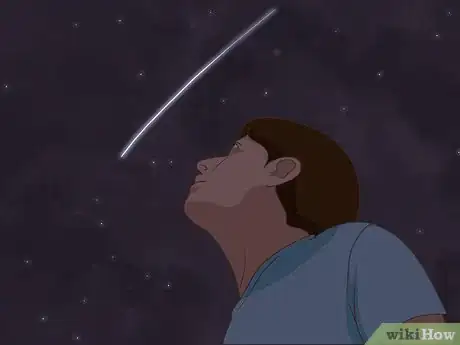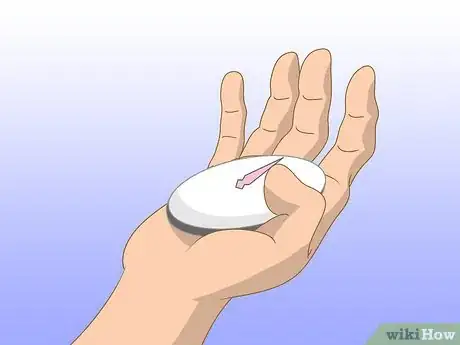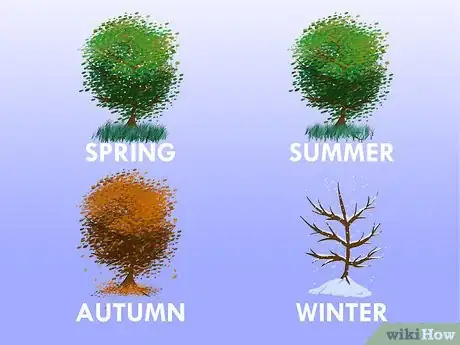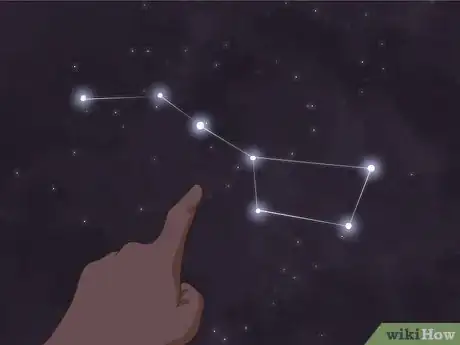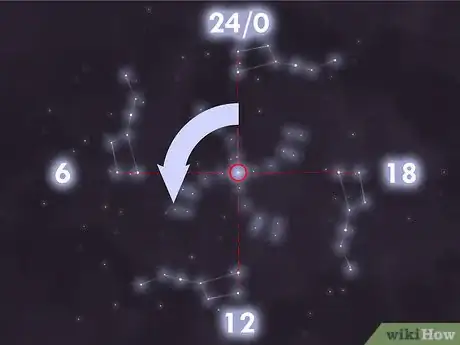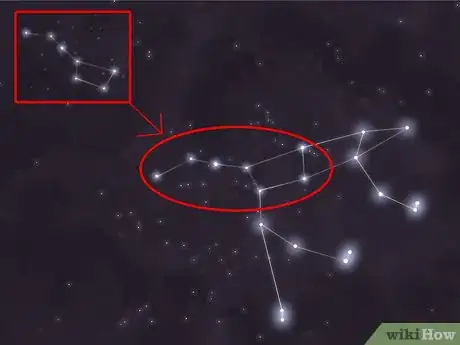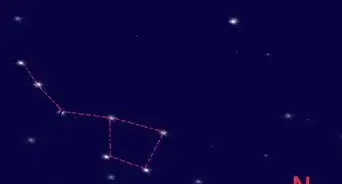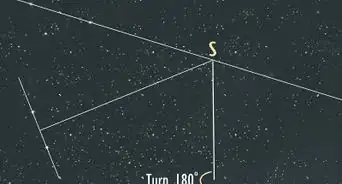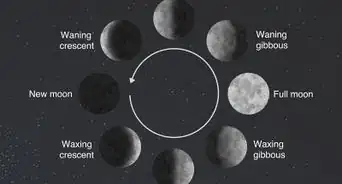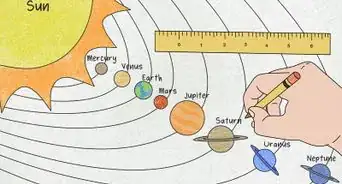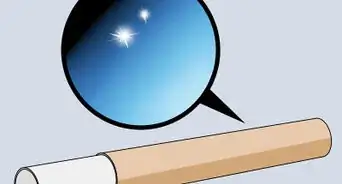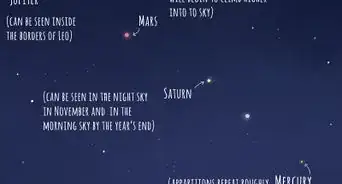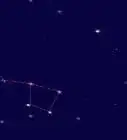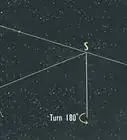wikiHow is a “wiki,” similar to Wikipedia, which means that many of our articles are co-written by multiple authors. To create this article, 15 people, some anonymous, worked to edit and improve it over time.
There are 14 references cited in this article, which can be found at the bottom of the page.
This article has been viewed 282,482 times.
Learn more...
The Big Dipper is perhaps the most famous grouping of stars in the sky. It is part of a bigger constellation of stars called Ursa Major or the Big Bear, and it features in the legends of many cultures. It can help you with navigation and telling time. It's not very difficult to spot if you know what you're looking for.
Steps
Getting in the Right Position
-
1Find the right spot. Position yourself in a location where there is not bright lighting. You will have a better chance of spotting the Big Dipper in an area not polluted with light.
-
2Look north. To find the Big Dipper, you need to look into the northern sky. Determine which direction is north using a magnetic compass or a map. Tilt your head back so that you are looking up at the sky at about a 60-degree angle.
- During midsummer and autumn, the Big Dipper will be closer to the horizon, so don't look up quite so high.
- If you are located north of Little Rock, Arkansas, you should be able to see the Big Dipper all night at any hour and any day of the year.[3]
- If you live as far north as New York or further north, the Big Dipper should never sink below the horizon. In southern locations, it can be more difficult to see the full Big Dipper in the fall, when some of its stars may be obscured.
Advertisement -
3Determine seasonal differences. The season matters here. If it's spring or summer, the Big Dipper will be higher in the sky. If it's fall or winter, the Big Dipper will be closer to the horizon.[4]
- The saying “spring up and fall down” will help you remember where to look for the Big Dipper.
- In the fall, the Big Dipper will rest on the horizon in evening. In the winter, the handle can appear to be dangling from the bowl. You will find the Big Dipper upside down in the spring and, in the summer, the bowl will lean toward the ground.
Locating the Big Dipper
-
1Spot the Big Dipper. The Big Dipper is shaped like a bowl and a handle. There are three stars in the Big Dipper's handle organized in a line. There are 4 stars that make up the Big Dipper's bowl (it looks like an irregular square). The entire Big Dipper looks somewhat like a kite, with the string being the handle and the bowl being the kite itself.[5]
- The last two stars of the Big Dipper's handle are called the pointers. They are called Dubhe and Merak. The brightest star is Alioth, which is the third star on the handle, closest to the bowl.[6]
- The tip of the Big Dipper's handle is called Alkaid. It is a hot star that means “the leader.” It is the third brightest star in Ursa Major and six times bigger than the sun. Mizar is next on the handle after Alkaid. It actually consists of two double stars.
- Megrez is the star that connects the tail to the base of the bowl. It is the dimmest of the seven stars of the Big Dipper. Phecda is known as the “thigh of the bear.” It is located to the South of Megrez and makes up part of the bow.
-
2Find the North Star. If you can find the North Star, you should be able to find the Big Dipper, and vice versa. The North Star is usually bright. To find it, look into the north sky up about one third of the way from the horizon to the top of the sky (which is called the zenith). The North Star is also called Polaris.[7]
- The Big Dipper rotates around the North Star through all of the seasons and through the night. The stars of the Big Dipper are as bright as those of the North Star. The North Star is often used for navigation because it points “true north.”[8]
- The North Star is the brightest star in the Little Dipper and the end of its handle. Trace an imaginary line from the North Star downward, and you should be able to find the two stars in the end of the Big Dipper's handle, which are called pointer stars because they point toward the Big Dipper. Polaris is about five stars farther away from the distance between the pointer stars themselves.
-
3Use the Big Dipper to tell time. The Big Dipper is what is called circumpolar. This means it doesn't rise or set like the sun. Instead, it rotates around the north celestial pole.[9]
- Throughout the night, it rotates around the pole, counter-clockwise, bowl first. It makes a complete revolution around the pole once per sidereal day. A sidereal day is defined as four minutes shorter than the standard 24-hour day.
- Thus, you can use the Big Dipper's rotations to keep track of time.[10]
Learning the Legends of the Big Dipper
-
1Study Big Dipper lore. Some Native Americans saw the bowl of the Big Dipper as a bear. The stars of the handle were three warriors chasing it.[11]
- Other Native Americans saw the Big Dipper's bowl as the bear's flank and its handle as the bear's tail. In the United Kingdom and Ireland, the Big Dipper is called “Plough,” which derives from Nordic stargazing in which the Big Dipper was believed to be the chief god, Odin's, wagon or chariot. In Danish, they call it “Karlsvogna” or Charles wagon.
- Various cultures see the Big Dipper as something different. In China, Japan, and Korea, it's a ladle. In northern England, a cleaver, in Germany and Hungary, a cart, and in the Netherlands, a saucepan. It's a salmon net in Finland and a coffin in Saudi Arabia.
- Escaped American slaves found their way to freedom in the north along the Underground Railroad by being told to “follow the drinking Gourd.” Thus, the Big Dipper was used as a navigational method. The Micmacs of Canada saw the Big Dipper bowl as being a celestial bear, with the three stars of its handle being hunters chasing the bear.
-
2Learn the Big Dipper stars' distances from earth. The stars that make up the Big Dipper are part of the Ursa Major Moving Cluster. The furthest star from earth, Alkaid, makes up the handle and is 210 light years from earth.[12]
- The other stars are Dubhe (105 light-years from earth); Phecda (90 light-years); Mizar (88 light-years); Merak (78 light-years); Alioth (68 light-years); and Megrez (63 light-years).
- These starts are in motion. Thus, in about 50,000 years, the Big Dipper will no longer retain the same shape.
Finding the Little Dipper and Ursa Major
-
1Use the North Star to find the Little Dipper. Once you've found the Big Dipper, you should be able to easily spot the little Dipper.[13]
- Remember that the two farthest most stars in the Big Dipper's handle point to the North Star. The North Star is the first star in the handle of the Little Dipper.
- The Little Dipper is not as bright as the Big Dipper. It looks similar to the Big Dipper, though. It has a handle made up of three stars that connects to a four-star bowl. It is harder to find the Little Dipper because the stars are not as bright in it, especially if you are in a city.
-
2Use the Big Dipper to find Ursa Major. The Big Dipper is what is called an asterism. That means it is a pattern of stars that is not a constellation. It is part of the constellation Ursa Major, the Big Bear.[14]
- The Big Dipper stars are the bear's tail and hindquarters. The Ursa Major constellation can be best seen in April at around 9 p.m. Using a drawing for reference (there are many online) should help you sketch out the rest of the stars that form the Big Bear once you find the Big Dipper.[15]
- Ursa Major is the third largest constellation and one of 88 official constellations.[16]
Community Q&A
-
QuestionIn which direction can we see the big dipper?
 KyleCommunity AnswerIt depends on the time and season. But if you look at the two outer stars in the bowl of the Big Dipper, and extend them by five times their own length then you will find the North Star, Polaris. Polaris is always on the North point.
KyleCommunity AnswerIt depends on the time and season. But if you look at the two outer stars in the bowl of the Big Dipper, and extend them by five times their own length then you will find the North Star, Polaris. Polaris is always on the North point. -
QuestionWhat is a light year and does that mean we are looking at the Big Dipper in the past?
 Community AnswerA light year is the distance that light travels in a single year, which is about six trillion miles. Thus, if we were looking at a star that is six trillion miles away from us, we are actually looking at the way it was a year ago. The same is true with the stars of the Big Dipper. We are actually looking at stars as they looked years ago. For example, Dubhe, one of the stars in the Big Dipper, is 105 light-years from earth, so we are seeing it as it looked 105 years ago.
Community AnswerA light year is the distance that light travels in a single year, which is about six trillion miles. Thus, if we were looking at a star that is six trillion miles away from us, we are actually looking at the way it was a year ago. The same is true with the stars of the Big Dipper. We are actually looking at stars as they looked years ago. For example, Dubhe, one of the stars in the Big Dipper, is 105 light-years from earth, so we are seeing it as it looked 105 years ago. -
QuestionIs there an Ursa Major Galaxy?
 KyleCommunity AnswerSeveral galaxies are found in Ursa Major, including the pair Messier 81 (one of the brightest galaxies in the sky) and Messier 82 above the bear's head, and Pinwheel Galaxy (M101), a spiral northeast of Ursae Majoris. The spiral galaxies Messier 108 and Messier 109 are also found in this constellation.
KyleCommunity AnswerSeveral galaxies are found in Ursa Major, including the pair Messier 81 (one of the brightest galaxies in the sky) and Messier 82 above the bear's head, and Pinwheel Galaxy (M101), a spiral northeast of Ursae Majoris. The spiral galaxies Messier 108 and Messier 109 are also found in this constellation.
References
- ↑ http://www.physics.ucla.edu/~huffman/finddip.html
- ↑ http://www.space.com/16270-big-dipper-night-sky-stargazing-tips.html
- ↑ http://earthsky.org/favorite-star-patterns/big-and-little-dippers-highlight-northern-sky
- ↑ https://earthsky.org/favorite-star-patterns/big-and-little-dippers-highlight-northern-sky/
- ↑ https://epod.usra.edu/blog/2020/06/big-dipper-and-the-seasons.html
- ↑ http://www.constellation-guide.com/big-dipper/
- ↑ https://solarsystem.nasa.gov/news/1944/what-is-the-north-star-and-how-do-you-find-it/
- ↑ http://survivaltopics.com/how-to-find-the-north-star/
- ↑ https://www.physics.ucla.edu/~huffman/dtime.html
- ↑ http://www.theskyscrapers.org/getting-to-know-the-big-dipper
- ↑ http://www.space.com/27758-big-dipper.html
- ↑ https://skyandtelescope.org/astronomy-news/a-new-way-to-see-the-big-dipper/
- ↑ https://earthsky.org/favorite-star-patterns/big-and-little-dippers-highlight-northern-sky/
- ↑ https://earthsky.org/favorite-star-patterns/big-and-little-dippers-highlight-northern-sky/
- ↑ https://stardate.org/nightsky/constellations/ursa_major
- ↑ http://www.fortworthastro.com/beginner2.html
About This Article
To see the Big Dipper, you’ll need to be north of latitude 25 degrees south. Otherwise, it will be hidden below the horizon. Go outside at night to an area that doesn’t have a lot of bright lighting, and look north. The Big Dipper has 4 bright stars that make up the bowl and 3 bright stars that make up the handle. During spring and summer, it will be located higher up in the sky. During fall and winter, it will be located closer to the horizon. You can use the Big Dipper to locate the North Star. Imagine a straight line extending up through the 2 stars that make up the outer portion of the bowl. Follow that straight line until you see a bright star, which is the North Star. To learn how to find the Little Dipper, scroll down!
